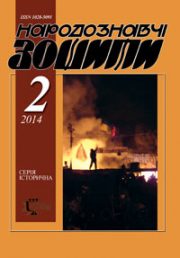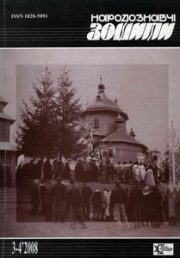The Ethnology Notebooks. 2024. № 1 (175), 199—204
UDK 75.056.017.4-023.5]:159.935-056.262
DOI https://doi.org/10.15407/nz2024.01.199
REVIEW OF WORLDWIDE ACCEPTED COLOR CODING METHODS FOR PEOPLE WITH VISION PROBLEMS
HULEVYCH Svitlana
- ORCID ID: http://orcid.org/0000-0002-6719-6453
- Master’s degree of Arts, PhD,
- Lviv National Academy of Arts,
- 38 Kubiyovycha St., Lviv, 79011, Ukraine,
- Contacts: e-mail: svetlanagulevich2020@gmail.com
Abstract. The culture of understanding the role of art in the modern world is developing in the direction of perceiving art as a set of symbolic systems, with the help of which humanity preserves and consolidates its values, recognizes itself in the surrounding world. The language of colors, that we are used to perceive at the level of visual analyzers, is no exception to this process. In the characteristics of any object and its main forms and indicators, we give the name of the color that belongs to the object. Problem: In the modern world, there is no single accepted system of color transfer through tactile perception for people with visual impairments. Single inventions and developments in different countries do not come to a coherent consensus, and have both their advantages and disadvantages. Scientists from various fields of science invent and patent their own developments in the recognition and designation of color for people with impaired vision. We will consider some of them in a scientific article, which will be divided into an overview of world research and a proposal of one’s own artistic project with further consideration for patenting.
The purpose of the article is to investigate the world experience of creating various systems and patent inventions for color coding for people with vision problems, to analyze the strengths and weaknesses of these methods. The object of the study is to consider the types of various color coding systems and patented inventions for the transmission of color display by means of tactile sensation for people with vision problems, and the subject is coding and semiotic symbols of color transmission. The methodological basis of the study is the empirical method as a descriptive system in helping to recognize the color world and its transmission for people with vision problems.
The awareness of the fact that colors affect a person in different ways and can evoke certain emotions adds relevance to the research. Physiological, psychoemotional, and even spiritual aspects of the influence of color on people are largely formed as a result of their experience of interaction with the surrounding world. Various aspects of the influence of color on a person have been strengthened on a conscious and subconscious level since ancient times and were an important factor in human communication, and therefore the true, as little as possible distorted color transfer in art is an essential condition for the performance of art’s communication function. From time immemorial, mankind has worked out various forms of transmitting knowledge about color, and among them is not only its visible reproduction. The most common non-visual form of color reproduction was and is the verbal description of colors. However, people have long been looking for other ways to convey information about color under conditions when it cannot be physically reproduced (lack of colors) or cannot be seen (visual impairment).
Keywords: Art, semiotics, people with vision problems, color coding, semiotics in art, color marking systems.
Received 27.12.2023
REFERENCES
- Lotman, Y. (1992). Selected articles (Vol. 1, pp. 191—199). Tallinn [in Estonian].
- Slater, S. (2021). The complete book of heraldry. China: Anness Publishing[in Chinese].
- Peter, W. (2003). Technique for enabling color blind persons to distinguish between various colors. Retrieved from: https://patents.google.com/patent/US7145571B2/en
- Neiva, M. (2010). ColorAdd: A Color Coding System. Retrieved from: https://www.color-blindness.com/2010/01/ 13/coloradd-a-color-coding-system/
- Fabricio, R. (2020). Evaluation of «See Color» Color Code System on Tactile Map. Brazyl’s’kyy kartohrafichnyy zhurnal (Pp. 34—48) [in Portuguese].
- Kursplats, M. (2016). Taktila farger. Retrieved from: https://www.kursplats.nu/tactile/ [in Swedish].
- (2021). News. Department of Social Protection of the Population. Press Service of the Regional State Administration. Retrieved from: https://old.loda.gov.ua/news?id=60928 [in Ukrainian].







